The evolution of video walls
by all | 11 February 2014 8:30 am
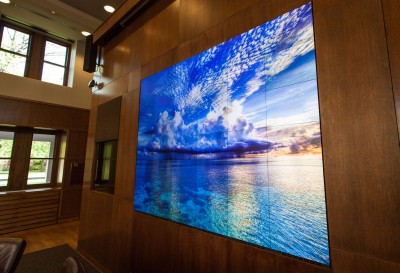 [1]
[1]By Peter Saunders
Video walls are quickly becoming commonplace in the digital signage industry. Their popularity in airports, restaurants, shopping malls, hotels, sports bars, exhibitions and other high-traffic environments is causing a jump in digital signage hardware sales. According to iSuppli, a market research firm, global sales of flat-panel displays specifically for video wall installations are experiencing a compound annual growth rate (CAGR) of 55.2 per cent, with close to 500,000 expected to be in use in 2014.
“There will be an approximately fourfold increase in the next few years,” says Jonathan Brawn, principal and co-owner of Brawn Consulting, which advises manufacturers, distributors, consultants and dealers in the professional AV industry.
A larger display area tends to draw and retain a larger audience. Multiple content sources can be used simultaneously. And higher aggregate displayed resolution provides the ability to deliver more detailed content than a single digital projector, for example, could throw onto a blank wall.
“Video walls can be more cost-effective than projections,” says Brawn. “Front-projection applications make up some 30 per cent of all digital signage, but they are more difficult to design, as the image’s appearance is more sensitive to lensing, lumen output, calibration, edge blending, viewing angles, ambient light and positioning. It takes more time to install when you have to deal with those environmental issues.”
As more video walls go up, some installations are using creative approaches to stand out, including unusual shapes and more immersive configurations. In this competitive and growing market, it is important for audiovisual (AV) integrators and other professionals in the industry to learn about various related technologies, from the screens themselves to options in hardware- and software-based processing.
 [2]
[2]“With today’s demand for higher pixel densities and capabilities for manipulating content from multiple sources, we need to make sure professionals understand these systems,” says Brawn. “Interest will only increase.”
From analogue to digital
The traditional definition of a video wall is a tiled display matrix. The tighter the tiling, the more clearly the displays will form a single wall.
Video walls in the early 1980s were built by mounting cathode ray tube (CRT) televisions (TVs) in a grid formation. These were typically 711-mm (28-in.) screens, with large gaps between sections. With each display hard-wired to a single content source, display options were limited.
“It was difficult to split a single input video signal to produce a large image across 16 monitors in a 4 x 4 array,” says Jeff Greenberg, CEO of Hiperwall, which develops video wall software.
By the standards of the day, signal splitting required a great deal of storage memory and computer processing. Early video wall processors were prohibitively expensive for most organizations.
“They used to be just for command-and-control rooms and specialty entertainment purposes,” says Brawn.
“One way around the signal splitting problem, when dealing with a permanently installed system, was to synchronize laserdiscs (LDs),” says Greenberg. “This process involved content specially prepared by a production house. One LD player per display would provide one part of the overall image. This method had remarkably good results, but only limited applications and no real-time image splitting.”
Content could not yet be moved or resized. Switching required rewiring or a patch panel.
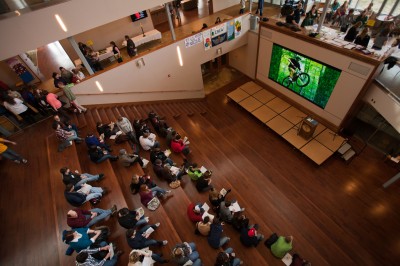 [3]
[3]By the late 1980s, lower-cost charge-coupled device (CCD) memory and more affordable, powerful and flexible processors helped reduce the cost of managing video walls. And new programmable processors meant the medium could be used more creatively, exploiting ‘multi-image’ capabilities. The screens began to change, as well.
“Around 1989, they went to rear-projection CRTs, which were often called ‘cubes,’” says Greenberg. “Each of these involved a CRT projector mounted inside an enclosure with a rear-projection screen. Cubes helped make the gaps between displays negligible and increased brightness and contrast, making video walls a more viable presentation medium.”
Cubes were indeed a significant step forward, becoming the primary video wall component for years to come. The concept still survives today, but with Digital Light Processing (DLP), liquid crystal display (LCD) and light-emitting diode (LED) backlighting technologies supporting higher resolution for crisper text and graphics than CRTs could.
Meanwhile, advances in processors enabled computers with multiple graphics cards to manage multiple windows of content simultaneously. By the late 1990s, processors could accept both digital and analogue sources of content.
“It was the start of the modern video wall era,” says Greenberg. “Since then, costs have come down, capabilities have improved and the medium has become more effective in a wide variety of venues.”
Configuration options
In a matrix-switch video wall configuration, dedicated ‘switchboard’ hardware supports the multiple input sources and output targets and can translate between different video formats.
Another option is a ‘daisy chain’ scalar setup, where one input is looped through multiple monitors, each of which picks up one quadrant of the signal. This is a simple setup, as the daisy chain capability is usually built into the screens, but it allows only one input at a time.
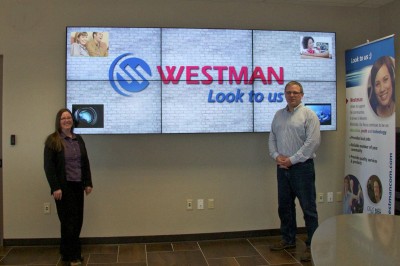 [4]
[4]Video processors provide greater flexibility for using multiple simultaneous sources and displaying content at different sizes and placements, similar to a real-time TV studio.
“They could be used in shopping mall concourses, for example, partitioned to display ads, wayfinding information and other content,” says Michael Ferrer, sales and operations manager for NEC Display Solutions.
Processor-based systems are still a more expensive option, however, and often require overprovisioning. So, to move beyond earlier systems’ limited scalability, an increasing number of video walls are now being based on a ‘distributed’ system.
In this type of configuration, autonomous content sources and targets are all connected through a standard communications system, such as a local area network (LAN), which can then be controlled with desktop software. This arrangement can either connect ‘dumb’ screens to computers or, like other digital signage networks, use displays with built-in computers.
“Embedded computers in the displays make it much easier to deliver the content over Ethernet connections,” Greenberg says.
“There are many variants of open pluggable specification (OPS) modules on displays to drive content and minimize wiring issues,” says Ferrer. “You can also use wireless-fidelity (Wi-Fi) or cellular connectivity for each screen.”
In any case, it is easy to add more displays as desired and there is less need for specialized hardware than in the past, reducing costs. Brawn Consulting estimates a distributed system can be built for around $73,000, compared to $90,000 for a comparable video processor-based system.
 [5]
[5]Screen selection
Another important choice is which type of display to use, as there are many options today.
“It’s best to try to avoid relying just on the published specifications for different display technologies and instead compare them side-by-side,” says Richard Heslett, senior product manager at Christie, which manufactures digital projectors and other AV components and systems in Kitchener, Ont. “You can bring two or three alternatives into the intended space and look at how well they work there, given factors like lighting and viewing angles.”
Indeed, the nature of the location will significantly inform the choice of technology, from billboard-scale LED arrays and bright drive-thru menu boards outdoors to closer-proximity screens indoors.
“An LED wall is brilliant outside with a long viewing distance, but would appear quite pixelated and too bright indoors,” says Heslett. “So, the choices inside would include LCDs, plasmas and rear projection.”
It is also important to consider how the video wall will be used. Some are deployed for short-term promotional purposes, but others must run 24-7 for years on end, e.g. in airports. These applications call for ruggedized hardware that can resist dust and other pollutants, along with fans to keep the constantly running screens cool.
Such issues have raised the question of energy efficiency in recent years. LCDs carrying the Energy Star mark, for example, are offering features like ambient light sensors to adjust screen brightness automatically, real-time schedulers to turn off those displays that do not have to run 24-7 and, increasingly, more efficient backlighting.
“The industry is moving toward LED-backlit LCDs,” says Rachel Karnani, large-screen product manager for NEC. “By reducing power consumption, this can mean almost $5,000 in lifetime savings for a 3 x 3-screen wall.”
LEDs also eliminate the mercury and reduce the emitted heat associated with fluorescent backlighting.
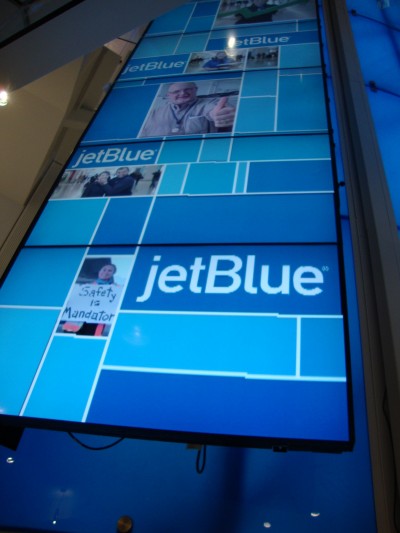 [6]
[6]Creating content
New software is simplifying the process of producing content for video walls, whether that content is positioned on an individual screen, on multiple tiles or across the entire wall. These programs are designed to deal with extremely large images more quickly than conventional desktop graphic design and image rendering software can muster, but also provide many of the same image-enhancement options, such as mosaic effects and filters.
“Now you can reduce the time from concept to delivery of content to multiple displays,” says Greenberg, “and the cost is lower than the previous processor-based systems. It’s just running on ordinary computers with minimum requirements.”
Even easily created content may need to be specially configured to be consistent with the video wall’s configuration. A 14 x 1-m (46 x 3.3-ft) tower of screens, for example, will need content that works esthetically across its unusual display area. No matter the hardware, after all, the primary purpose of any video wall is to showcase its content.
“The technology may be the missile, but the content is the payload,” says Brawn.
Image interruptions
With regard to the displayed content, software is also providing more options for dealing with the ‘seams’ in video walls. While LCD and plasma display manufacturers have reduced their bezels to as thin as 2 to 5 mm (0.08 to 0.2 in.), they still inherently cause interruptions in a wall-sized image.
So, one option is to enable ‘bezel compensation,’ which hides enough of the image’s pixels to maintain linearity across the screens, which is usually desirable for photos, artwork and video.
“Video wall software can compensate for the bezels with black ‘gutters’ between the facets of the image,” Greenberg explains.
Alternatively, bezel compensation can be disabled to ensure no content is obscured. Linearity is lost, but all pixels are visible, which is usually important when displaying text, charts and maps.
A third option, of course, is to use the aforementioned rear-projection cubes for a more seamless appearance. This way, a video wall can be built with less than 1 mm (0.04 in.) of bezel space between its facets.
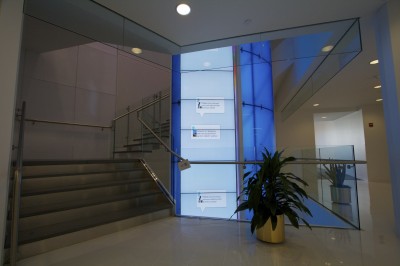 [7]
[7]Screen calibration
Displays should also be calibrated for colour and brightness. ‘Edge compensation,’ for example, levels out the brightness that would otherwise fall off at the bezels where screens meet. This helps produce more uniform images across the entire video wall.
Another type of screen calibration comes during hardware installation.
“You need a mounting system that can provide sufficient structural strength along a flat surface,” says Greenberg. “There are mounts made specifically for video walls today, with mechanisms that ensure the screens are properly aligned and spaced. They are adjustable and modular.”
In some instances, however, despite the flexibility of multi-tile configurations, a projection will work better.
“While video walls provide many advantages, projectors can do what video walls can’t,” says Brawn. “They can work on curved surfaces, avoid bezels and enable very large images.”
Enabling interactivity
Some video walls are even being made interactive, reflecting the public’s growing familiarity with touch screens and gesture-based systems—but this entails a whole new set of technical issues.
 [8]
[8]“With interactivity, the person is standing right in front of the wall,” says Brawn, “so you need not only the ability to support touch or gestures, but also sufficient pixel density for image clarity at a shorter viewing distance—along with a more comfortable temperature, given LCDs and plasma screens both emit heat from the front. Some flat panels are now specially designed to vent heat out the back instead.”
Another issue is the user’s eye comfort when looking at a screen at arm’s length. Special coatings will help optimize the colour temperature and focus for the viewer. While anti-glare coatings can cause image ‘speckle,’ diffusion and glossy screens tend not to do so. Rear-projection cubes, by the nature of their design, are also not as harsh to look at up close.
Along with coatings, touch-screen overlays can be added to standard LCDs to make them interactive. While this technology is common today, however, a fully touch-enabled video wall is not a simple matter.
As integrators become more creative, however, more immersive video walls will become part of the built landscape. Software will allow more complicated content to be handled in a user-friendlier fashion with less expensive processors—and then sent wirelessly to more energy-efficient, eye-pleasing screens.
With files from Brawn Consulting, Hiperwall, NEC Display Solutions, Christie, the Digital Signage Expo (DSE) and the Digital Signage Federation (DSF). For more information, visit www.brawnconsulting.com[9], www.hiperwall.com[10], www.necdisplay.com[11], www.christiedigital.com[12], www.digitalsignageexpo.net[13] and www.digitalsignagefederation.org[14].
To read the sidebar, 10 Steps to Video Wall Success, click here[15].
- [Image]: http://www.signmedia.ca/wp-content/uploads/2014/02/Christie-MicroTiles_MUNK-School-of-Global-Affairs-cover.jpg
- [Image]: http://www.signmedia.ca/wp-content/uploads/2014/02/Chrsitie-MicroTiles-at-Fresh-Retail-Store.jpg
- [Image]: http://www.signmedia.ca/wp-content/uploads/2014/02/Christie-MicroTiles-at-Clarkson-University.jpg
- [Image]: http://www.signmedia.ca/wp-content/uploads/2014/02/Westman-Cable-Hiperwall.jpg
- [Image]: http://www.signmedia.ca/wp-content/uploads/2014/02/Chrsitie-MicroTiles-_Einstein-image-at-Perimeter-Institute.jpg
- [Image]: http://www.signmedia.ca/wp-content/uploads/2014/02/JetBlue-Hiperwall-WingWall-bottom.jpg
- [Image]: http://www.signmedia.ca/wp-content/uploads/2014/02/HiperwallJetblue2.jpg
- [Image]: http://www.signmedia.ca/wp-content/uploads/2014/02/T3-Agency-Showcase.jpg
- www.brawnconsulting.com: http://www.brawnconsulting.com
- www.hiperwall.com: http://www.hiperwall.com
- www.necdisplay.com: http://www.necdisplay.com
- www.christiedigital.com: http://www.christiedigital.com
- www.digitalsignageexpo.net: http://www.digitalsignageexpo.net
- www.digitalsignagefederation.org: http://www.digitalsignagefederation.org
- here: http://www.kenilworth.com/publications/smc/de/201207/files/53.html
Source URL: https://www.signmedia.ca/the-evolution-of-video-walls/